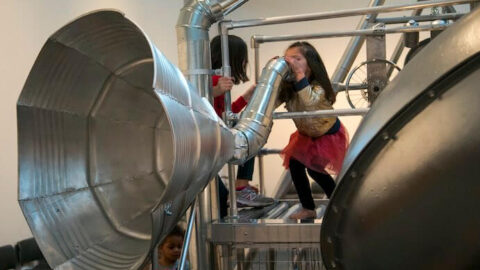Dotting the landscape of what can often seem like a stagnant operatic scene, festivals ensure that fresh air blows in unexpected places. This was true of Opera Omaha’s ONE Festival, which took place March 30–April 14, and which I attended during its final weekend from April 11–14. Under the leadership of Opera Omaha General Director Robert Weitz and Artistic Director James Darrah, the ONE Festival brought together musicians, dancers, filmmakers, and others for a multidisciplinary program in locations throughout the city, often throughout every day. Touring artists through a mix of variously-scaled works both old and new, Opera Omaha’s project to rearrange and (re-)foreground every aspect of theatrical performance made for a lithe, protean operatic approach.
The first performance of the weekend, choreographer Chris Emile’s For Research Only, took place in the morning at KANEKO, a gallery space in downtown Omaha’s historic Old Market. Split between a series of large, interconnected rooms on two floors, the gallery’s joined and converted warehouses provided a floor plan for the work, which moved in a procession throughout the upper level. To begin, each audience member was assigned a card with a number and ushered into the first room. We surrounded a translucent tarp enclosure in the center, through which we viewed the dim outlines of performers, seeming independent to go about their business as though preparing backstage. Synth-heavy elevator jazz filtered in from the hallway, reminiscent of the vaguely-sinister Americana wallpaper of Robert Ashley’s operas. Over loudspeakers, a disembodied voice instructed the audience to move to opposite sides of the room depending on their card number. As we executed this minor choreography of our own, we watched and listened as the performers acted out stage cliches: dancers getting dressed; a diva sharing her unsolicited vision with the director; an upstart hoping to be introduced to influential patrons.
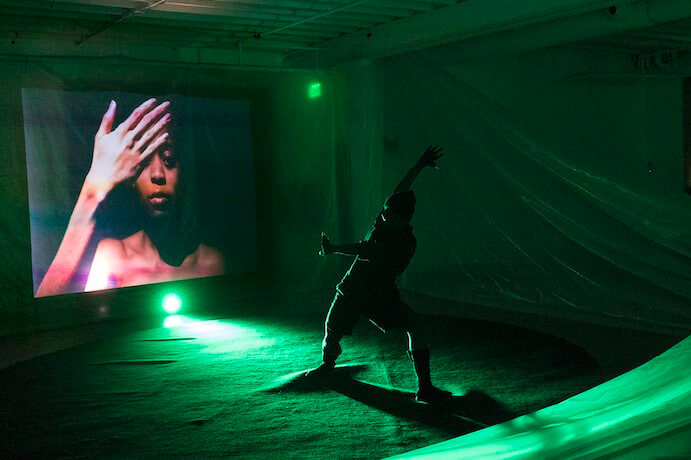
Before long, we were all instructed to move into the other room. Another, more transparent enclosure suggested a music video set, with dancers and cameramen working to the accompaniment of what were now revealed as members of the International Contemporary Ensemble (ICE)’s increasingly cinematic contributions. Another set of audience members were instructed to sit closer as the performers played out their takes; a third episode placed the artists finally behind a clear enclosure in the original room for more (now post-show) dialogue and the musings of an anonymous interviewee, played over intercom: “You go from being a person, to an object, to an image […]. You have to struggle to maintain your autonomy in relationship to that image that people map onto you and want to keep onto you…”
If For Research Only came across as the ONE Festival’s least-focused contribution, with its emphasis on increasing visibility marred by murky conception, Lileana Blain-Cruz’s production of Faust fared better in its theatrical progression from darkness to light. The 1859 Gounod opera, performed with the Omaha Symphony and Opera Omaha Chorus under Steven White, was the oldest work of the weekend by far—however, staged in a version unheard for over 150 years, the work cast off its historical accumulation of recitative and ballet to reveal a piece of darkly funny camp.
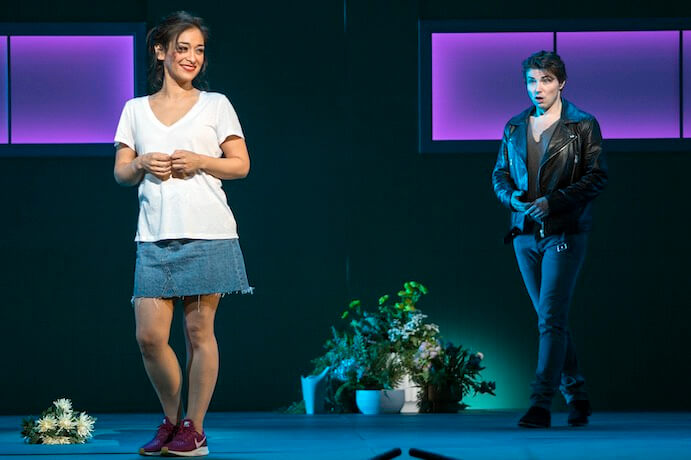
The title character, sung by Sebastian Guèze in an Omaha debut, paid dearly for his all-consuming fervor for knowledge, youth, and love. Blain-Cruz cannily set the work in a contemporary staging that nonetheless did not interfere with the libretto, emphasizing the scenario’s in-built modernity: the young Faust’s adventures bring him, by turns, into a raucous Spring Break beach party, the working-class Miami apartment of Marguerite (sung by Cecilia Violetta López in another Omaha debut), and a glittering, drag-like representation of Hell. Present nearly throughout, David Pittsinger excelled both as vocalist and actor in the role of the rakish Mephistopheles, with a powerful bass-baritone signaling the existential threat concealed under the Devil’s obscene, Vegas-act exterior. Even Marguerite’s ex machina salvation at the end only heightened the piece’s sense of surreal spectacle, placing Faust in line with the Festival’s decidedly contemporary overall focus.
Faust’s often-debased carnival atmosphere found somewhat more genial expression at the Joslyn Art Museum in Playground, a short operatic scene performed in a hybrid jungle gym/sound sculpture designed by Ellen Reid. ICE percussionists Ross Karre and Clara Warnaar teamed with mezzo-soprano Naomi Louisa O’Connell, with the former playing on swings, slides, and chains as the latter intoned chant-like melodies through a length of metal pipe. More to do with the stylization of childhood curiosity than with any concrete narrative, the work alternated rhythmic episodes with reflective, ambient passages in which a wide-eyed O’Connell traversed different parts of the installation while singing in a dark, rich timbre. Children in the audience excitedly played on the sculpture afterward, activating its myriad bells and whistles to produce a boisterous rush of sound.
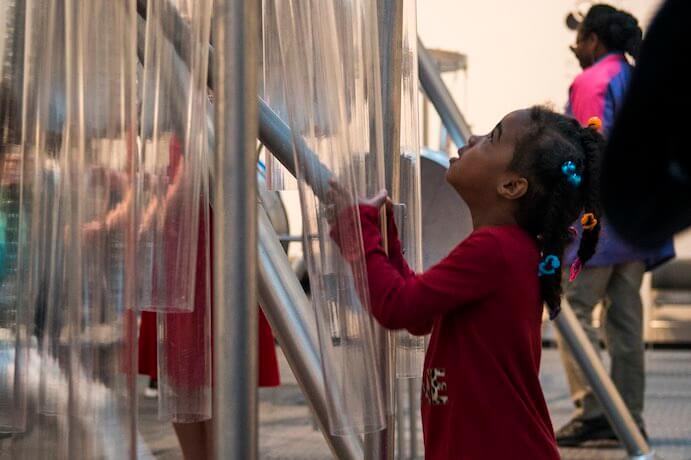
Included among the ONE Festival’s other, long-running intermedia projects were a series of afternoons dedicated to 20th- and 21st-century film and video called CINESounds, curated by Karre. Expecting a single film with live scoring improvised by members of ICE, I went to see Albert Lamorisse’s silent 1956 featurette The Red Balloon. A beloved piece about the adventures of a boy who befriends the titular, sentient balloon, it provided a welcome refresher as it projected the balloon in vivid Technicolor against the gray streets of postwar Paris. I was pleasantly surprised to find in addition that several shorter films, split between abstract video art and documentary/travelogue work, were shown afterward. On the Coast, collaboratively produced and directed by Zeynep Dadak and Merve Kayan, was a particularly striking short about a Turkish vacation town populated only during the summer months. Dadak was present to introduce the film, whose analog, nearly-silent capturing of place is gorgeously undertaken through landscape shots, close-ups, social scenes and the occasional beach PSA (including one warning of a runaway horse, whose jarringly emaciated figure roams the streets towards the film’s end).
The most substantial contemporary work among the ONE Festival’s offerings was also its closer; Philip Glass’ 1996 “dance opera” Les Enfants Terribles concluded the weekend. Directed by Darrah and based on Cocteau’s 1929 novel of the same name, the chamber opera places siblings Lise and Paul (sung by Vanessa Becerra and Theo Hoffman) at the center of a terrible, Freudian “Game” in whose inscrutable progression the other characters become entrapped as voyeurs, fetish-objects, and projections. The orphaned siblings depend dangerously upon one other; attempts to extricate themselves from each other’s influence inevitably ends in tragedy for their friends and suitors Agathe and Gerard, sung respectively by Naomi Louisa O’Connell and Adrian Kramer.
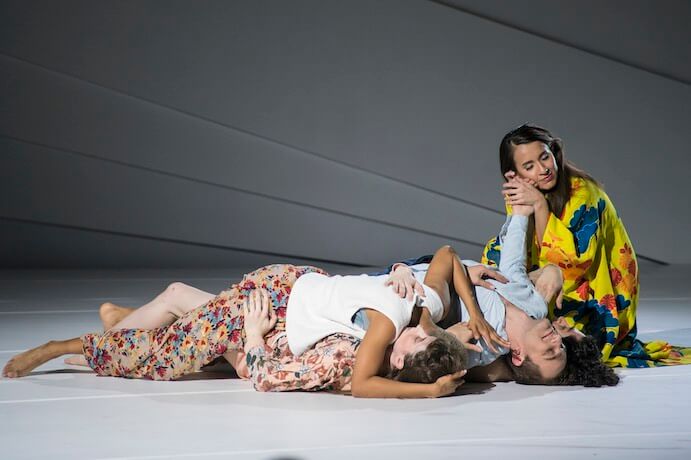
Four dancers shadow the vocal quartet against a white rectangular stage and backdrop; an outer pathway is separated from the main platform by a trough of trash as Lise and Paul isolate themselves ever further, encroaching upon and rearranging spaces to their liking. Lise marries a wealthy businessman only for him to die, leaving Paul, Agathe, and Gerard to move into the mansion she inherits; the surreal scenario is heightened by Agathe’s resemblance to the brutal Dargelos, a schoolboy friend and obsession of Paul’s who disappears after injuring the latter during a snowball fight. Any sense of linear narrative seems only to be a pretense for the externalized rehearsal of unresolvable, psychosexual tensions, which constitute the work’s main drama: the scoring, reduced in the ensemble to three pianists, turns the piece into a kind of opera for répétiteurs. Singing from all four vocalists was of the first rank; Becerra’s Lise was particularly compelling in her unhinged deviousness.
Proving to be a fertile ground for operatic experimentation and the commingling of different artistic practices, the 2019 ONE Festival succeeded because it did precisely the opposite of Les Enfants Terribles’ tragic protagonists: where Paul and Lise closed themselves off from the world, Opera Omaha sought to go into it. In opening itself both to local and national artistic communities, and by taking an expansive view of opera within a larger domain of performance-related activity, Opera Omaha achieved thematically-complex programming while also attaining a level of intimacy and community involvement rare within the opera machine. Close collaborations in the form of installation, sculpture, opera, film, and dance allowed for cross-pollination between the artists themselves, and the integration of concerts into the fabric of the city enabled the experience of theatrical works both small and large with a unique immediacy and lasting resonance.
